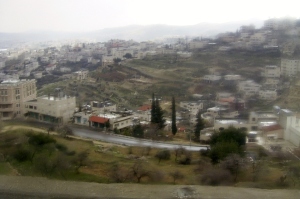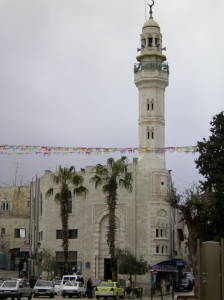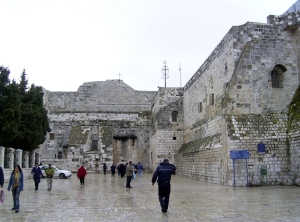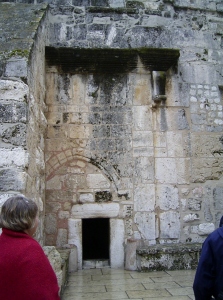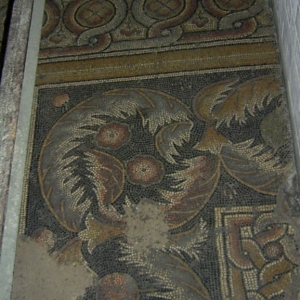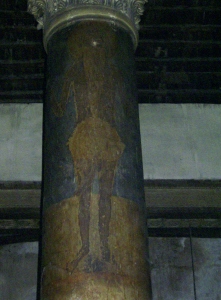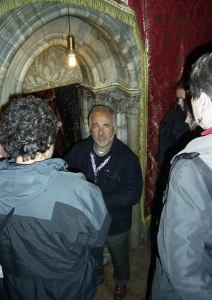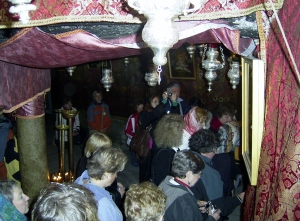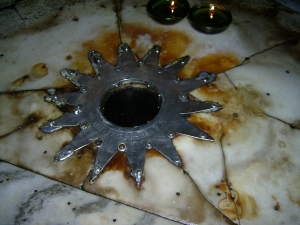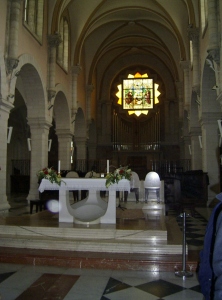I visited Bethlehem as part of a pilgrimage to Israel I took in 2007. The weather the day I was there was overcast and rainy—I was there in February—so the photos I took are less than wonderful. But when Jesus was born in Bethlehem (likely in March rather than in December), Mary and Joseph probably faced similar inclement weather. As my Christmas gift to you, here are a few photos from my visit. I hope you enjoy them.
Bethlehem is 6 miles south of the Old City of Jerusalem. Depending on traffic, the drive takes about 12 minutes plus a stop to change vehicles when you pass through the West Bank Wall to enter Bethlehem and the area controlled by the Palestinian National Authority.
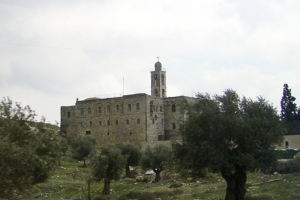
Mar Elias Monastery is a 6th c Greek Orthodox monastery in south Jerusalem, on a hill overlooking Bethlehem and Herodion. Photo taken on the Hebron Road.
Just outside of Bethlehem is the Mar Elias Monastery. At the time of year I was there—during the rainy season—the grass was fresh and green and wildflowers were beginning to bloom. Perfect for grazing sheep: “And there were in the same country shepherds abiding in the field, keeping watch over their flock by night.” (Luke 2:8) Also seen in this photo are some of the many olive trees growing in the area around Bethlehem. Since the 4th century artisans in Bethlehem have been crafting articles from olive wood to sell to pilgrims visiting the newly constructed Church of the Nativity in Bethlehem. To this day, production of items from olive wood to sell to tourists remains a major staple of the local Bethlehem economy and source of employment. For more about this industry, see http://www.bethlehemfairtrade.org.
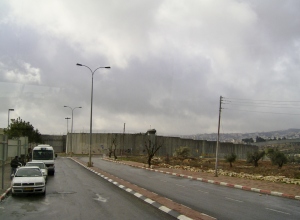
Approaching the “Separation Wall” (a.k.a. the West Bank Wall) where visitors must stop to change vehicles before entering Bethlehem.
When visitors finally reach Bethlehem they must stop at the separation wall and change from Israeli transportation (in my case, a tour bus) to Palestinian transportation in order to enter Bethlehem.
As you drive towards the Church of the Nativity in the center of Bethlehem, you see the “little town of Bethlehem” spread out on the hills and in the valley below the road from Jerusalem.
Seventy years ago, 85% of Bethlehem’s population was Christian; today that percentage has shrunk to less than 20% Palestinian Christian. In the center of Bethlehem is Manger Square. At one end of Manger Square is the Mosque of Omar (Umar), built in 1860 to commemorate the Caliph Umar’s visit to Bethlehem.
At the other end of Manger Square is the entrance to the Church of the Nativity. The church was originally built by the Emperor Constantine’s mother, St. Helena, in AD 339 to mark the place where tradition said that Jesus was born. Fire destroyed that building which was rebuilt by Emperor Justinian I in 565. This version of the church remains today with modifications made by Crusaders in the 11th and 12th centuries and repairs by European interests in the 15th century.
On Christmas Eve, Christian pilgrims from around the world gather on Manger Square to sing Christmas carols before Midnight Mass inside the church.
Entrance to the Church of the Nativity is through the so-called Door of Humility. As you can see in this photo, the door was originally much larger. The square shape above the door marks the entrance built by Justinian. Below that you can see the outline of the earlier Romanesque doorway built by the Crusaders. Under Ottoman rule the doorway was blocked to just this short opening. The reason given for the smaller doorway was to keep raiders from riding their horses into the church. The more popular reason is that anyone entering the church is force to bow low in humility.
Inside, you can see mosaics from the floor of the original 4th century church.
There are 30 of the original 44 columns from the original 4th century. Crusaders decorated the columns with pictures of the saints. The columns are made of polished pink limestone.
The Grotto of the Nativity below the altar is the focal point of the church.
Inside the Grotto of the Nativity can be wall-to-wall pilgrims.
Pilgrims come to touch or even kiss the silver star on the grotto floor. The star marks the spot where Jesus was supposedly born. The theft of the star in 1847 by the Ottomans was one of the contributing factors leading to the Crimean War (1854-56).
Much of the Church of the Nativity is Eastern Orthodox in style and worship. Adjacent to it is the Roman Catholic Church of St. Catherine and Franciscan monastery.
Someday, I hope to be able to celebrate midnight Mass at this altar in Bethlehem. It’s on my bucket list.









